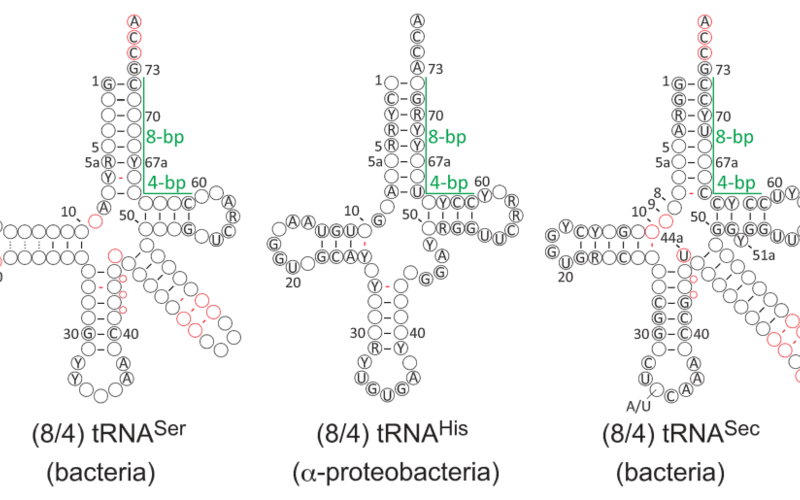Nature and nurture of genetic code evolution
Research in the Söll laboratory explores the genetic code translation in a wide range of living species. Through genetics, biochemistry, structural analysis, and molecular biology, we are studying bacterial, archaeal and eukaryotic systems to uncover new strategies of genetic code expression. We extensively use this knowledge to develop new tools for synthetic biology and extend the chemistry of living systems by enabling robust and efficient genetic encoding of unnatural amino acids and amino acid-like molecules in a test tube or in a living cell.
Genetic code evolution
One key question in biology is how is the genetic code expressed in nature.
For decades, the genetic code was thought to be universal and immutable, in agreement with Jacques Monod’s famous pronouncement that ”what is true for E. coli is true for the elephant”. However, codon reassignments first produced with the Trp codon in mitocondria are now known to be far more widespread. Such deviations in the genetic code expression include stop codon reassignment, codon reassignment, ambiguous translation, recoding, and lack of use of a codon; and these deviations were shown to help organisms to survive unique environmental conditions or adapt to complex life cycles.
In the genomic and metagenomic era we and others have shown that many organisms have a non-canonical usage of codons and carry alternative (or additional) translational components supporting the same codon assignment. For instance, we have recently found that amino acids Sec and Cys share the same codon in diverse bacteria. Also, a few other bacteria phyla were shown to use the same codon CUC to encode two different amino acids, Leu and Ser. Collectively, these studies illustrate that genetic code is far more diversified in nature as has been generally thought. Now we are working to explore this diversity across all kingdoms of life. Perhaps even more exciting direction of the lab’s research centers around evolving new organisms with artificial genetic codes. For instance, in cooperation with the Budhisa team we have recently evolved a new E. coli strain that lacks tryptophan residues in its cellular proteins. This semi-synthetic strain carries an artificial amino acid Tpa that substitutes tryptophan in every of ~20,000 sites in E. coli proteins. This strain provided a new tool to evolve artificial proteins in a living cell.Now we are working to explore this diversity across all kingdoms of life.
Perhaps even more exciting direction of the lab’s research centers around evolving new organisms with artificial genetic codes. For instance, in cooperation with the Budhisa team we have recently evolved a new E. coli strain that lacks tryptophan residues in its cellular proteins. This semi-synthetic strain carries an artificial amino acid Tpa that substitutes tryptophan in every of ~20,000 sites in E. coli proteins. This strain provided a new tool to evolve artificial proteins in a living cell.
Repurposing translational machinery for synthetic biology
Another research avenue in the Söll laboratory is to develop new tools for synthetic biology to enable genetic encoding of unnatural amino acids or amino acid-like molecules.
We engineer multiple components of the translation machinery – mRNAs, tRNAs, aminoacylt-tRNA synthetases (aaRS), elongation factor EF-Tu/EF-1A, the ribosome and others; to enable efficient protein synthesis with unnatural and rare amino acids. One recent progress in this direction allowed us to solve a promiscuity problem for engineered aaRS: we have designed new variant of TryRS enzyme with unprecedentedly high specificity to a particular unnatural amino acid. This work has accomplished an important milestone on the way to engineer a living cell encoding multiple synthetic amino acids.
We also use the power of structural biology to visualize components of the translation machinery caught in the act of protein synthesis. This helps us to uncover fundamental mechanisms of protein synthesis and use this knowledge for rational design and directed evolution of “orthogonal” translation systems.
Protein engineering using unnatural and rare amino acids
We also take advantage of our expertise in genetic encoding of unnatural and rare amino acids to engineer or modify protein activities.
One current project in the Lab utilizes a site-specific insertion of rare amino acid selenocysteine. We use this approach to improve industrially relevant enzymes by replacing catalytically active cisteine residues in their active sites by far more reactive selenocysteine. This cysteine-to-selenocysteine replacement may dramatically boost enzymatic or redox activity of a protein of interest.
Another research direction in the Lab centers around the genetic encoding of phosphorylated amino acids. We have previously engineered an E. coli strain for genetic encoding of phospho-serine, and now we are using a similar strategy to extend the repertoire of phospho-amino acids in the genetic code of bacterial and eukaryotic species.




